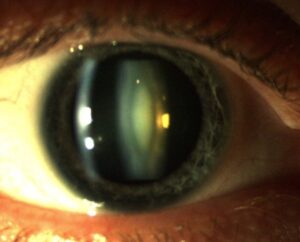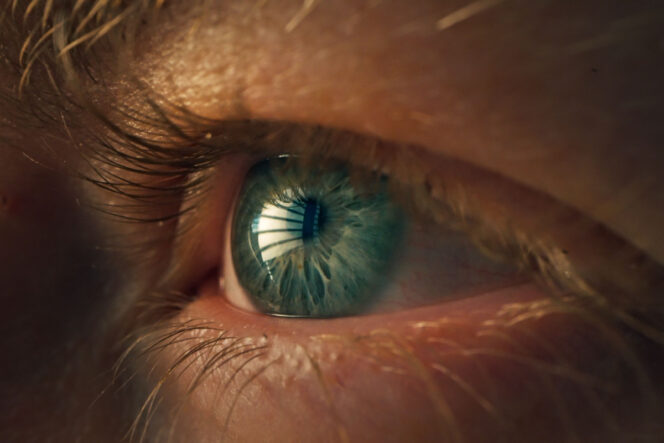A nuclear cataract is a serious eye condition that can lead to blindness. It is caused by exposure to radiation, and unfortunately, there is no cure. However, there are ways to protect yourself from developing this condition. In this blog post, we will discuss the dangers of nuclear cataracts and how to protect yourself from them. We will also provide some tips on what to do if you think you may have a nuclear cataract.
Contents
What Is A Nuclear Cataract?
 A nuclear cataract is a type of cataract that affects the nucleus of the eye’s lens. This type of cataract is formed when proteins in the center of the lens become clumped together, causing it to become cloudy and impair vision. It can occur at any age, however, they are more common in people over 40 years old.
A nuclear cataract is a type of cataract that affects the nucleus of the eye’s lens. This type of cataract is formed when proteins in the center of the lens become clumped together, causing it to become cloudy and impair vision. It can occur at any age, however, they are more common in people over 40 years old.
There could be several possible causes of nuclear cataracts. These include:
- Prolonged exposure to UV: It is believed that prolonged exposure to UV rays from the sun can cause damage to proteins in the eye’s lens, leading to nuclear cataracts.
- Diabetes: People with diabetes are at an increased risk for developing nuclear cataracts due to changes in blood sugar levels and other factors.
- Aging: As we get older, our bodies naturally produce more of certain proteins that can accumulate in the lens and cause a nuclear cataract to form.
- Heredity: Certain genetic factors can increase one’s risk of developing a nuclear cataract.
These are some common causes of nuclear cataracts that are worth taking into consideration. When you are aware of the possible causes of nuclear cataracts, you can take the necessary steps to protect your eyes.
What Are Some Signs To Look For?
There are a few signs that you should look out for if you think you may have nuclear cataracts. These include:
- Blurred vision: It is one of the earliest signs of a nuclear cataract. It can cause your vision to become hazy and distorted, making it difficult for you to focus on objects.
- Light sensitivity: If you experience increased light sensitivity from bright or glaring lights, you may have a nuclear cataract.
- Colors fading: As the cataract progresses, colors may start to fade and appear less vivid.
- Double vision: When looking at something, you may see two images instead of one. This double vision is a sign that the cataract has progressed.
These are very common and yet often overlooked symptoms that can be indicative of a nuclear cataract. If you experience any of these symptoms, it is important to schedule an appointment with your eye care professional as soon as possible for further evaluation.
When you stay up to date on your eye health and get regular checkups, you can catch nuclear cataracts early before they become more serious. And even prevent them from occurring in the first place.
What Are Some Dangers Of Nuclear Cataracts?
Now, this is something that is not to be taken lightly. Nuclear cataracts can cause several dangers in the form of risks and complications. That being said, it is important to be aware of these dangers and understand the importance of getting regular eye examinations. Let’s discuss a few dangers of nuclear cataracts below.
Impaired vision
One major danger of nuclear cataract formation is impaired vision. Nuclear cataracts can cause a person’s vision to become blurred and distorted due to the thickening of the lens in the eye, making it more difficult for light to pass through and focus properly. This can lead to problems with seeing clearly at night, being able to distinguish colors accurately, and difficulty seeing objects up close.
Glare and halos
Another potential danger of nuclear cataracts is the development of glare and halos around bright lights. Glare can cause temporary blindness or fuzziness in vision while halos appear as rings of light surrounding a bright source of light. This can lead to fatigue and uncomfortable glare during tasks that require good vision, such as driving at night or reading.
Increased sensitivity to light
Finally, nuclear cataracts can make a person more sensitive to bright light due to the clouding of the lens in the eye. This increased sensitivity can lead to discomfort and may even cause pain when looking at bright, sunny days or objects with reflective surfaces.
Other risk factors
In addition to these, there are also some complications that you can have with nuclear cataracts. Some people have been known to develop inflammation of the eye, dry eyes, glaucoma, and vision loss. It is important to be aware of these potential complications and take steps to protect your vision.
All in all, the dangers of nuclear cataracts should not be taken lightly. If you are concerned about your vision and think that you may be at risk for this condition, it is important to speak with your doctor right away. They can evaluate your eye health and help you identify the best course of action.
How Can You Treat It?
 It is important to find and treat nuclear cataracts early on before the clouding of the lens becomes too severe. Your treatment options depend largely on your eye doctor’s assessment of your vision and lifestyle needs. Therefore the treatment options are divided into two parts: non-surgical and surgical treatments. Let’s discuss both in detail:
It is important to find and treat nuclear cataracts early on before the clouding of the lens becomes too severe. Your treatment options depend largely on your eye doctor’s assessment of your vision and lifestyle needs. Therefore the treatment options are divided into two parts: non-surgical and surgical treatments. Let’s discuss both in detail:
Non-surgical
In this method, there are various treatment approaches.
- Prescription glasses and contact lenses: These can help improve vision, but they do not treat cataracts themselves. For example, if you have a mild case of nuclear cataracts, your doctor may recommend simply wearing glasses or contacts.
- Sunglasses: Wearing UV-protective sunglasses can reduce the risk of ultraviolet light triggering the development and growth of cataracts.
- Eye drops: Eye drops containing antioxidants, such as vitamins C and E, lutein, and zeaxanthin, may help to slow the progression of cataracts.
- Healthy eating: In many cases, a healthy diet is the best way to reduce the risk of developing cataracts in the first place. Eating a balanced diet with lots of fruits and vegetables can help protect your eyes from damage.
- Eye exercises: There are some eye exercises that can help reduce your risk of developing cataracts, such as palming and focusing.
With these things in mind, it’s important to contact an ophthalmologist and have a professional eye exam to properly diagnose any potential cataracts.
Surgical
Surgery is the only proven way to completely remove a nuclear cataract and restore vision. In this procedure, an eye surgeon replaces the affected lens with a transparent lens, typically made of flexible plastic. The procedure is performed using a local anesthetic and usually takes about 30 minutes to complete.
In most cases, vision improves within a few days of the procedure and continues to improve over the following months. There are also different types of surgery that can be used to treat nuclear cataracts, including laser-assisted surgery, which may offer faster recovery times.
Overall, these two are the most common treatments for a nuclear cataract, but there are other methods available as well. Be sure to discuss all available options with your doctor so that you can make an informed decision about the best course of action.
How To Prevent It?
You might want to take measures to protect your eyes and prevent the development of nuclear cataracts. Here are some things you can do:
- Wear sunglasses that block 100 percent of UV radiation – even on cloudy days.
- Avoid looking directly at the sun, including during an eclipse.
- Have regular comprehensive eye exams to detect early signs of cataracts and other vision-related problems.
- Eat a healthy diet that includes plenty of fruits, vegetables, and omega-3 fatty acids (found in fish such as salmon).
- Quit smoking, or don’t start in the first place. Smoking can greatly increase the risk of cataracts.
- Get regular exercise and manage stress levels.
- Monitor your medications for side effects that can affect vision, such as glaucoma drugs or corticosteroids.
- Use protective eyewear when working with hazardous materials or in certain recreational activities, such as skiing or snowboarding.
- Wear a wide-brimmed hat when spending time outdoors.
By following these preventive steps, you can significantly reduce your risk of developing nuclear cataracts and maintain healthy vision for years to come. If you notice any changes in your vision, be sure to contact your doctor right away so they can help diagnose and treat any potential issues. With proper care, you can enjoy a clear vision for years to come.
Conclusion
To conclude, nuclear cataracts are often caused by overexposure to radiation and can cause vision loss if left untreated. While there is currently no way to prevent nuclear cataracts, it is possible to reduce the risk of developing them by limiting exposure to UV light and other preventive measures.
You should always consult an eye care professional if you think that you may be at risk of developing nuclear cataracts. They will be able to advise you on the best ways to protect your eyes from further damage and ensure that any treatment is effective.
For more information and guidance, be sure to contact Mantra Care. At MantraCare we have a team of experienced eye surgeons, who will be happy to answer any questions on cataract surgery. Call us at +91-9711116605 for any inquiries.
